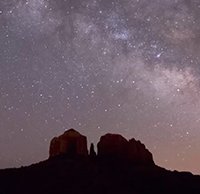Remove comatic aberration from your astro images with this tutorial
posted Wednesday, December 2, 2015 at 2:21 PM EDT

Tyler Sichelski of Lonely Speck has created a helpful video tutorial for removing coma aberration from night sky images in Photoshop.
Comatic, or coma, aberration is when point light sources become distorted and take on a comet-like shape. Coma aberration is most common at the edge of the frame at and near a lens' widest aperture. The aberration is caused by the lens not projecting point light sources at the edge of the frame at the same size as it projects point light sources in the center of the frame. For more information on different kinds of aberrations that are relevant to astrophotography, check out Lonely Speck's Practical Guide to Lens Aberrations and the Lonely Speck Aberration Test.
In Tyler's tutorial, he goes through his process of removing comatic aberration from an image taken with his Canon EOS 6D and Tokina 16-28mm f/2.8 lens. Through a process similar to removing blemishes from portrait images, he uses a custom brush and the clone stamp tool to make the stars smaller and appear sharper. This is a pre-processing method, so you should save your typical post-processing workflow until after you address the aberration issues.
Tyler creates a custom brush preset using the ellipse tool and then duplicates his original background layer. Using the clone stamp tool with the new custom brush, he selects a region close to the star and then uses the custom brush to stamp over the distorted stars in the image. It can be a time-consuming process, but it will definitely work and make your night images look sharper. Tyler also covers an approach to dealing with potential blending issues that can arise around particularly bright stars. Check out the tutorial below!
To see more information about the tutorial and to also download the high-resolution image file that Tyler uses in his tutorial if you'd like to follow along, see here.
To see more of Tyler Sichelski's work, check out his website and his Instagram. For more information on astrophotography, including tons of free guides and tutorials, check out Lonely Speck.
(Seen via ISO 1200)